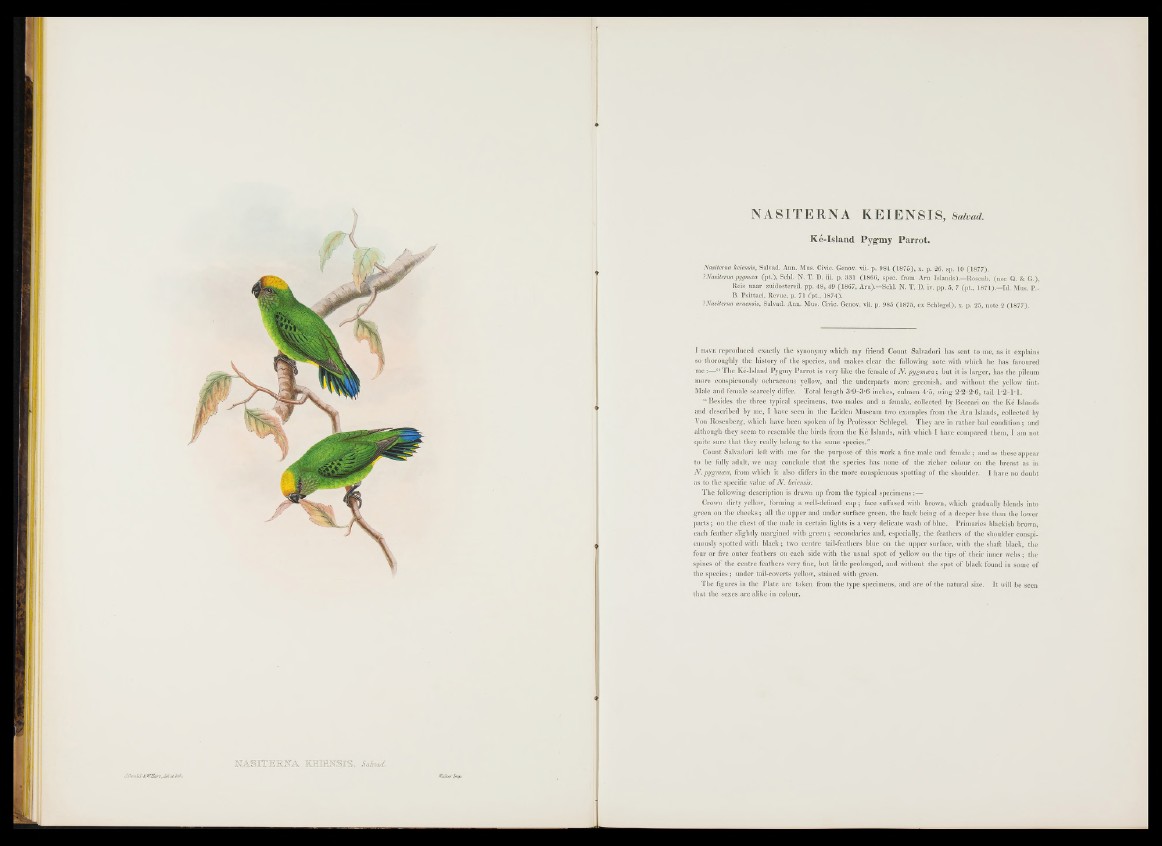
JSTA.SXTERISTA. K E X E N S X S , Satra/L.
NASITERNA KEIENSIS, Salvad.
Ke-Island Pygmy Parrot.
Nasiterna keiensis, Salvad. Ann. Mus. Civic. Genov, vii. p. 984 (1876), x. p. 26. sp. 10 (1877).
?Nasiterna pygmcea (pt.), Schl. N. T. D. iii. p. 331 (1866, spec, from Aru Islands).—Rosenb. (nec Q. & G.),
Reis naar zuidostereil. pp. 48, 49 (1867, Aru).—Schl. N. T. D. iv. pp. 6, 7 (pt., 1871).—Id. Mus. P.-
B. Psittaci, Revue, p. 71 (pt., 1874).
?Nasiterna aruensis, Salvad. Ann. Mus. Civic. Genov, vii. p. 985 (1875, ex Schlegel), x. p. 25, note 2 (1877).
I h a v e reproduced exactly the synonymy which my friend Count Salvadori has sent to me, as it explains
so thoroughly the history o f the species, and makes clear the following note with which he has favoured
u ie :— “ T he Ke-Island Pygmy P a rro t is very like the female o f N. pygmcea; but it is larger, has the pileum
more conspicuously ochraceous yellow, and the underparts more greenish, and without the yellow tint.
Male and female scarcely differ. Total length 3 '9 -3 -6 inches, culmen 4-5, wing 2-2-2*6, tail 1-2—1-1.
“ Besides the three typical specimens, two males and a female, collected by Beccari on the Ke Islands
and described by me, I have seen in the Leiden Museum two examples from the Aru Islands, collected by
Von Rosenberg, which have been spoken o f by Professor Schlegel. They are in rather bad condition ; and
although they seem to resemble the birds from the Ke Islands, with which I have compared them, I am not
quite sure th at they really belong to the same species.”
Count Salvadori left with me for the purpose o f this work a fine male and female; and as these appear
to be fully adult, we may conclude th at the species has none o f the richer colour on the breast as in
N. pygmcea, from which it also differs in the more conspicuous spotting o f the shoulder. I have no doubt
as to the specific value o f N . keiensis.
T he following description is drawn up from the typical specimens:—
Crown dirty yellow, forming a well-defined c a p ; face suffused with brown, which gradually blends into
green on the ch eek s; all the upper and under surface green, the back being o f a deeper hue than the lower
p a r ts ; on the chest o f the male in certain lights is a very delicate wash o f blue. Primaries blackish brown,
each feather slightly margined with g r e e n ; secondaries and, especially, the feathers o f the shoulder conspicuously
spotted with b lack ; two centre tail-feathers blue on the upper surface, with the shaft black, the
four or five outer feathers on each side with the usual spot o f yellow on the tips o f their inner webs; the
spines o f the centre feathers very fine, but little prolonged, and without the spot o f black found in some of
the sp ecies; under tail-coverts yellow, stained with green.
The figures in the Plate are taken from the type specimens, and are o f the natural size. It will be seen
th at the sexes are alike-in colour.